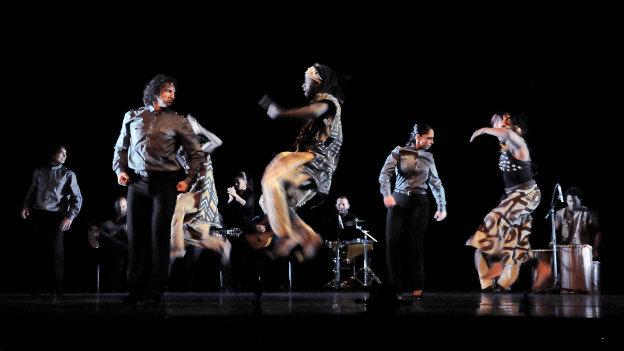Spanish flamenco guitars, African koras and kalimbas, and Afro-Venezuelan tambores. Loose-limbed Senegalese dancers, legendary Sevillian singers, verbatim voice-overs about migration, and compás clapping in counter-rhythm to the djembe beats.
Quimeras is indeed a strange beast, created by Paco Peña in collaboration with various Spanish, South American, and African dancers and musicians. The core of the company are very specifically of the Andalusian flamenco tradition, whereas the ‘Africans’ are a kind of drawn-together mish-mash from various traditions, although this fits the logic of the piece, which is purportedly about migration from Africa to Spain. Throw in direction by Jude Kelly, and you have indeed a chimera…
There is an irony in the naming of the show – for Paco Peña, it is in acknowledgement of his interest in exploring the notion of illusion – but the outcome is that the creation of such a hybrid creature perhaps inevitably results in something that is both fantastical and unbelievable, an odd mismatch of component parts.
The show opens with a solo spot from the man himself, followed by a kind of battle-of-the-bands play off between the Flamenco team and the Africans. We get a Cook’s Tour of classic palos (flamenco music forms), and a selection of traditional African songs. All well and good – everyone is of course highly skilled, and it is a well-executed showcase of talents. There’s some interesting mixings that start to emerge, most notably a beautiful section in which singer and dancer Marisa Camara (originally from Guinea, now settled in Madrid) takes the spotlight for what appears to be a poignant lament for the lost motherland, or perhaps the moment of decision to leave – a slow and mesmeric Dougoulente (work dance), with a choreography of gestures distilled from the physical work of toiling the land, accompanied by Spanish guitar and African kora (a gorgeous harp-like instrument). This is countered with a scene called Un Sueno (a dream) – an excuse for one of the flamenco women dancers to epitomise a dream-image of Spain, white dress and shawl swirling dervish-like in the moonlight. There’s a rather odd choice to introduce pre-recorded music here, in what is (other than the recorded voice-over texts and an occasional sound-effect) an otherwise live show.
Towards the end of the first half, we learn of a journey by boat (telling rather than showing, in this case) then get a strong choreographic section in which the four flamenco dancers, now out of traditional costume and wearing all-black trousers and shirts, immediately giving them the look of fascist ‘black shirts’, face off the Africans with a staccato drumming of the feet, the stage swept with searchlights. So, we understand, the immigrants have arrived to a less-then-welcoming environment.
The second half starts with a lovely image of the Africans grouped downstage, faces illuminated in the spotlight. We hear a voice that says: ‘Our dream was to get to Europe. Now we have got to Europe, what is our dream?’ A great question – but having been raised, it is not really explored. What follows is puzzling: a very long traditional flamenco Fiesta scene straight out of a Carlos Saura film – the Spanish troupe sat in a horseshoe clapping and olé-ing, singers and dancers taking turns to up the ante for the next performer. The Africans are lurking on the edges – an image of exclusion from Spanish society. The flamenco is all very thrilling, the performances of a high quality, if lacking something of the duende passion you’d find in an Andalusian nightclub (and from the audience’s response it is clear that the flamenco is actually what they are here for) – but the image of inside society versus excluded outsider is formed very quickly, so there is a question mark over the length of the scene within the context of the show as a whole.
We then move out on the streets, for some very lovely African rap and blues, and to a scene between two male dancers of the opposing camps that is so clichéd in its narrative of uptight European versus loose-limbed, let-it-all-out African that it is embarrassing – with a ‘we are all brothers’ huggy ending that has toe-curling undertones of Ebony and Ivory. This all seems just far too patronising.
The question for me is what Jude Kelly’s role in all this was: with auteur Paco Peña at the helm, and two credited choreographers on board alongside Kelly in her directing role, there seems to be nobody actually steering the ship dramaturgically. It rocks all over the place – now a showcase of music and dance talent, now attempting to be a theatre show with something to say about the plight of immigrants.
Quimeras raises the age-old problem of attempting to theatricalise intrinsically theatrical forms such as flamenco. When the drama is inherent to the form, trying to twist the form to create drama can be tricky (as many artists, from The Tiger Lillies to Camille O’Sullivan, have discovered). It is not a problem confined to music and dance that wants to tell stories: witness the eternal dilemma for circus-theatre. The problem here, as is often the case, is with attempting to keep a linear narrative and a bunch of self-contained showcase pieces balanced.
Unfortunately, with all its component parts jammed together in such an odd hybrid, this chimera loses both the fire that should be at its flamenco heart, and the sting that could be in its narrative’s tail.


